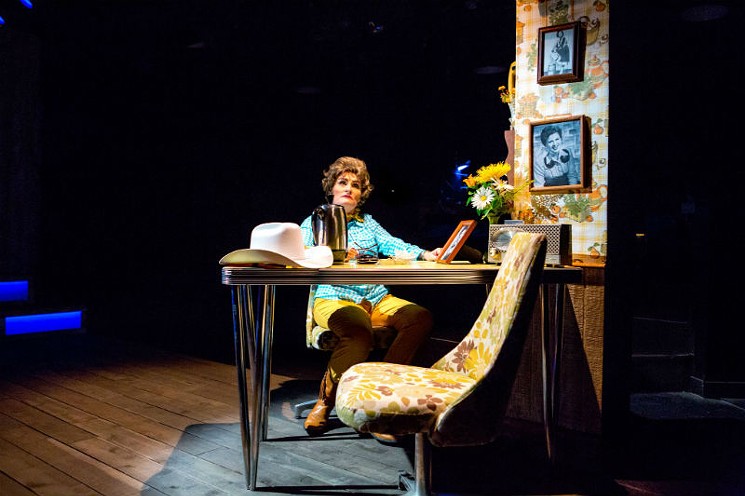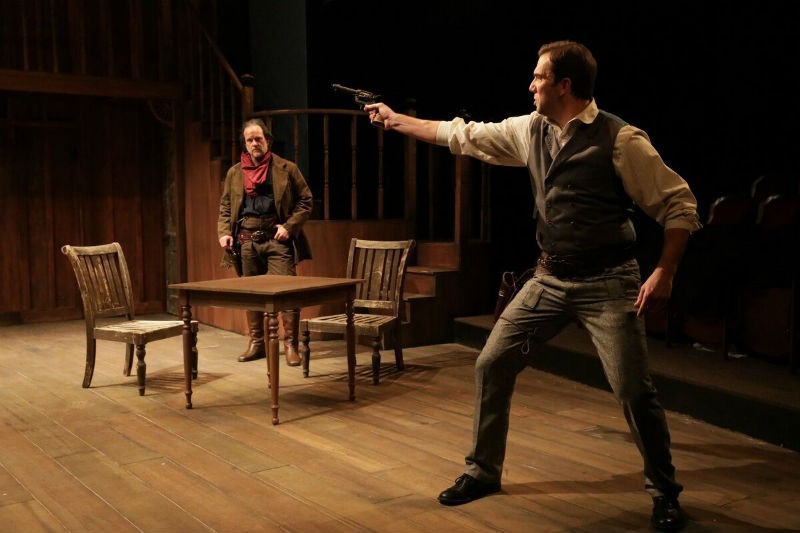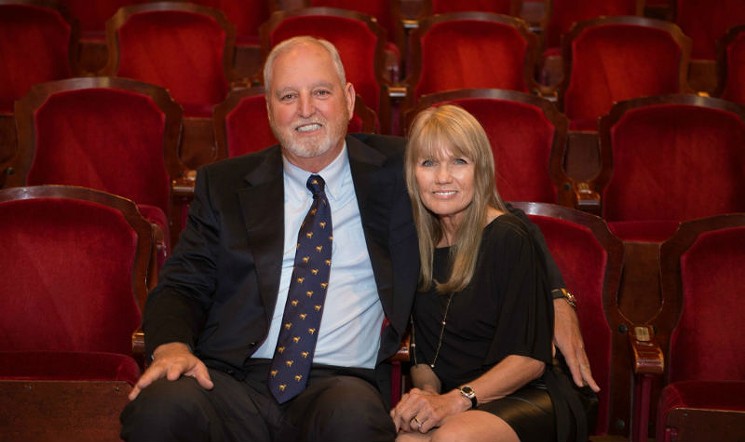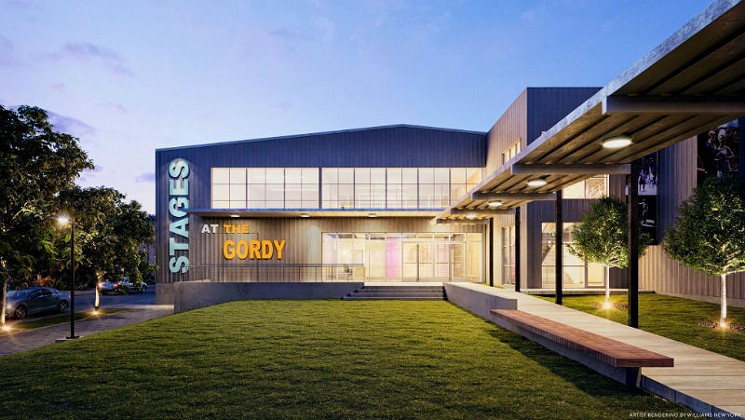They knew they needed a redo to their building at 3201 Allen Parkway and in 2014 were finally able to buy the building outright from the city of Houston. As Artistic Director Kenn McLaughlin said, “We bought this building with the intent of a very discreet upgrade to mostly carpeting and drapes kind of thing.”
Moving out the pillars that blocked sight-lines from the two stages was beyond this dream. That would cost millions of dollars, he said they were told. So again, baby steps. Buy the building, polish it a bit and grow some more.
Except. Dominoes.
“The minute that we would touch a carpet tile in this place we would trigger a problem for parking,” MxLaughlin explained. “The parking situation for this building is grandfathered into an earlier time. The minute we start to change anything on this building we run into a huge parking problem.” And it’s already tough on some SRO theater nights to park there – now it was going to get worse?
“It’s the No. 1 concern that our audiences have. So we knew parking had to be a part of the solution for us going forward.”
Enter serendipity. Fate. Karma. Whatever you want to call it.
A nearby tract of land at 800 Rosine was under contract to a developer. On top of that land stood a nondescript building that the Museum of Fine Arts, Houston, had been using as a storage and restoration facility for its art works worth millions of dollars when they weren’t on display.
MFAH was moving its materials to new digs and selling the property. The developer’s plan was to tear down the building and put 22 town houses in its place. McLaughlin and other Stages personnel approached the developer. “We said we need a few more square feet to put a parking garage up which was our intent to solve the parking problem. We ended up in a negotiation about that happening.”
And then the bottom fell out of the developer’s deal.
“Subsequent to that conversation, the city would not give them the cutouts to put townhomes they wanted. They needed some variances and they couldn’t get them. So their contract essentially fell apart,” he said.
Despite being within easy walking distance from Stages, McLaughlin said he’d never been inside the MFAH warehouse. Going there, he said, “I just had an incredible feeling about the warehouse. It’s a beautiful structure.”
So with the blessing of the developer, Stages approached the Museum of Fine Arts who owned the land and entered into negotiations and purchase of the land.
The result, as announced late last year, is a $30.5 million project with a plan for groundbreaking this coming spring and a grand opening in time for the 2019-20 theater season
This is a story that Kenn McLaughlin is probably going to enjoy telling for the rest of his life.
***

Notice the beams running the length of the stage on both sides in this production of Mack and Mabel.
Photo by Jon Shapley
As Kenn McLaughlin points out, a lot of alternative theaters in the ‘70s grew up in these warehouses like the former MFAH home – in fact warehouses have been home to several theaters in Houston such as Mildred’s Umbrella and 4th Wall Theatre Company at Spring Street Studios.
As it turned out as plain Jane as the MFAH building looked on the outside, its inside was well, stunning. “The thing about the building that was critical to our thinking was its structure; its incredible bones because it held millions and millions of dollars worth of incredible art. It has mechanical systems through the roof. It has humidity controls for every eight by eight square foot and theses guys were going to raze it,” McLaughlin said.
"We changed our thinking and we went back to the board,” McLaughlin said. The board set about another assessment – what was it that Stages really needed. They took their reconfigured plan to Sterling Associates, capital campaign consultants, who said, yes, you can do this. And what followed was two years of hard work as they kept their redesigned dream mostly to themselves until it was announced publicly.
There were a lot of threads running at the same time. Besides the more extensive fund-raising that would have to be done, they needed a designer. They picked Charcoalblue, an London-based architecture firm whose business has recently started to explode in the United States.
"They're not a cookie cutter kind of firm," said Lise Bohn director of Resource Development at Stages, What followed were lots of conversations about what kind of theater did Stages really want? What was most important to their audiences?
"The one thing we knew forever is that 'Intimacy' that’s the word our audiences use most," said McLaughlin. "Our kind of bold step was to say 'How can we amplify that? What will make it more intimate?' and Charcoal Blue” really responded to that.
The answer was to design a space with three different theaters expanding upon the warehouse space they already had. There is a parking garage with a new building attached to the warehouse. The arena stage would have 220 seats in three rows, with a single balcony and can convert to a thrust stage as needed. The second stage, a dedicated thrust stage would go from 171 seats in their present theater, to 253 seats. But because of a different design, actually audiences will be closer to the stage. The farthest seat is only 14 feet from the stage. And good news for all: the seats themselves are bigger and pitched at a better angle.
The third stage, the warehouse stage in the original building with up to 138 seats, will be designed to support long-running shows and will be similar to their present arena stage. “Patsy Cline could just go on and on,” McLaughlin said. Right now they sometimes have to cut runs short, even walking away from ticket sales said McLaughlin and Bohn. Now, just as in New York, Chicago, D.C. and LA, some most popular shows will be able to run indefinitely, which is definitely good for the tourist trade as well as hometown folks, McLaughlin said. "But Houston doesn’t have that venue and what that venue ultimately does is drive tourism."
***

Sometimes, as in Always Patsy Cline, the best thing to do is cover the pillars in wallpaper and hang a framed photo or two on them.
Photo by Os Galindo
Those effing pillars.
No only do they block sightlines, and present strategic challenges for staging, but one of them actually comes down right in the middle of a pair of seats in the audience. (Ticket buyers are asked if they mind ahead of time.)
"I think we’ve been incredibly creative in dealing with those pillars," McLaughlin said. "But you are looking through a box to see a play. It's like watching television in a letter box .The psychology of that box kind of limits your imagination." All of that will be gone in the new theater, he said. "It's just you and the actor in open space. That will feel remarkably different."
"The pillars actually became grounding points for the actors," he said. "Go to the pillar and turn. Stand really close to the pillar because that’s the only way the audience can see you."
In working through their plans for the new building, they made mock-ups of the stages so they could sit in front of them. The stages are elevated. The first two rows are sunken "When you walk into the room your mind should think about the stage and nothing else. This is about this platform and this play," McLaughlin said.
There are plays they're saving for the new building, some of them plays McLaughlin has wanted to do for years. . "I want to do Sunday in the Park with George. I’ve always wanted to do Sunday in the Park with George. It's one of the greatest pieces of literature in the world. But it cannot work in our spaces as it is written."
"We’ve done all sorts of wacky things," McLaughlin said. . We never should have done Mack and Mabel in our space but what the hell. I think what we did was pretty magical and crazy and that was kind of the point because Mack Sennett was crazy and that was kind of the driving principle but that’s a play that would certainly work much better in spaces like this."
"These stages are going to change the way we use our imaginations. They allow us to do things we simply can’t do right now."
According to Bohn, “It’s also about freeing up the creativity from having be spending a huge amount of time and resources thinking about overcoming obstacles. And now all that creative energy and thought can just go to working on the art as opposed to solving the problems. Which is what we spend so much of our time doing in our current spaces."
Lee Nel, the lead designer for Charcoalblue, says her firm comes with no set ideas but bases its designs on what the clients want and what is possible financially.
They took a theater tour with McLaughlin and other Stages personnel in Baltimore and New York. "We saw a boatload of theaters," McLaughlin said.
“We’ve talked about texture a lot because that not only plays into the acoustics of the room, but what the materials are going to feel like and how they're going to react to sound, "Nel said.
"It’s been quite a process trying to make this a flexible, immersive space," she says. "The hardest challenge has not only been trying to create three unique rooms but also to fit them into the footprint that the building has taken on. In terms of fitting one of those into an existing building and fittin two others into a smaller addition and making the whole building function holistically. And to make it a space they could easily use."
***
So how does a theater that starts out only being able to afford to buy the building they've been leasing (which they're now going to have to sell) and fix the carpet and the drapes make such a huge jump to building a whole new 66,850-square-foot theater complex, with three sets of dressing rooms, with bathroom stalls moving from 25 to 56 — the first major infrastructure investment in its 40-year history? Enter the Gordys. This is another story Kenn McLaughlin loves to tell.
"The Gordys have been coming to Stages for 40 years," McLaughlin says. "When they were young, they lived in Kingwood. He worked downtown for an oil and gas company and she would take the bus from Kingwood down to Stages and that was their date night."
"A year ago Russell called out of the blue, called the box office to say 'My wife and I, 43rd wedding anniversary, I want to do something special Can I present her a ring during the Honky Tonk Angel show cause I know you guys do kind of crazy things like that.'" Stages said yes.
"We wrote it into the Christmas Spectacular. He gave her the ring as sweet as could be. And we began really a conversation in what our dreams were. It's a fantastic fit with us. They are very focused on this neighborhood. They love our plays. They know what we do. They both graduated from Sam Houston State University. So it doesn't hurt that I teach there and so many of our kids are there. Their interests are in the future generation. That's what our interests are."
Russel Gordy came up through oil and gas but he's become a real estate developer, Bohn said. "He's the developer of the Buffalo Heights project between Heights and Studemont on Washington. He just opened Gordy & Sons Outfitter here on Waugh so they also have a strong interest in this neighborhood and they are quite literally neighbors."
The couple has offered to match all new donations up to $5 million to bring the project to completion. When the announcement was made on December 28, the Stages already had commitments of $20 million. In return, the new theater will be called The Gordy.
The sense of community is very important to what Stages is trying to do next both McLaughlin and Bohn said. They envision having their complex open to the public, and having a place where smaller theater companies can come in to plan and rehearse. McLaughlin and Stages are already well known in the Houston theater community as helping other companies with advertising, costumes and props. So this is a natural expansion upon what they have already been doing.
"More theater makes us better. The more art in the system the better community we have. The more people go through the system the more they become hungry for more theater," McLaughlin said.. "If we could be a part of really generating activity in the whole community then we're really doing our jobs.
"Plus we’re only here for a very short period of time.Somebody else is going to be behind us. I want to make sure there’s life in this system in this theater for as long as there can be."
Asked why Stages has done so much working with college students and discovering young talent, McLaughlin said:
"When I was growing up I was mentored by some of the greats. That influenced the way I think. We are part of a centuries old tradition, " McLaughlin said. "My first professional job which was ten days out of college, I was walked into a rehearsal hall, they said 'Hey, you're doing the understudy on this' and they said 'Ken, this is Ruby Dee and this is her husband Ozzie Davis'. I was dumbfounded. 'Oh and this is Horton Foote.' These are the first three people I met in my professional career.
"So if I can help young people be in the room with the top tier talent from Houston, yes."




